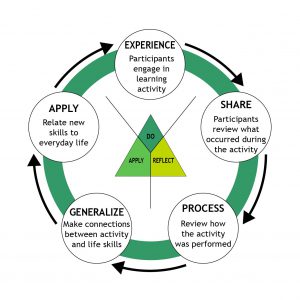“Hands-on,” and “learn by doing” are terms you often hear in 4-H and they both refer to the Experiential Learning Model, which is the instructional strategy we use in 4-H programs. The hands-on experiences that 4-H is known for offer youth the chance to engage all their senses in the learning process. One of the prevalent models guiding hands-on experience design is the experiential learning model (Experiential Learning Model, 2022). Figure one illustrates this model, highlighting the three notable stages of doing, reflecting, and applying which serve as the core of the model. While the hands-on experience is critical, it is also important to remember that reflection and a focus on how to apply what was learned are also necessary for a compelling experience to result in impactful learning outcomes.
Designing for Experiential Learning
When designing programs, it is important to keep in mind that leaders must intentionally foster experiential learning through the careful planning and execution of programs. Three tips to keep in mind are:
- Build in Time – While this may seem obvious, it is important to keep in mind that time needs to be built into the program to allow for a thorough exploration of an experience, the reflection, and the application phases. The amount of time needed will likely vary with the experience and how many youth are involved. While the experience generally takes up the most time, be sure to reserve time for reflection activities. It is through the intentional carving out of time that it is possible to foster the whole of the experiential learning process. Ten to fifteen minutes for a reflection activity should be sufficient.
- Identify a Leader – Identify an individual to take point with each section or activity that is planned. This will help relieve some of the pressure and will allow for focused efforts on each section. When considering the reflection stage, it is important to identify an individual who will be able to facilitate the process in a meaningful way. Specifically, someone who will be able to ask unassuming questions and will be able to respond to the information shared, and relate it to the experience and application stages.
- Mix it Up – Utilize a variety of different activities to facilitate sharing and reflection. Reflection activities may be anything from using a thumb ball with specific questions passed around to free-form conversation as participants feel comfortable in contributing.
Learn More
Experiential learning is easier with practice, but we have several resources to help!
- Florida 4-H Experiential Learning Cards are a handy reference tool that include questions you can ask youth for each step of “do-reflect-apply” to help them process the activity. Once you have done this a few times, it will come naturally and you won’t need to refer to the cards, but these are helpful if you are new to this teaching strategy.
- Participate in a workshop! Both online and in-person workshops are available for volunteers who want to learn more!
-
- California 4-H has developed an excellent website with tip sheets, resources, and even an online module to learn and practice experiential learning. They have a toolbox to support volunteers and 4-H professionals- it is all free and you don’t have to register to use the tools!
- During our Northwest 4-H Volunteer Forum, January 20-21, we will have a guest speaker who will lead us all in a workshop on experiential learning! If you would like to attend, registration opens in 4Honline on October 15th.
Norman & Jordan, 2019)
Learn More
The experiential learning process is broad and well-covered in studies and educational design. If you are interested in learning more, check out the resources referenced in the article below.
- Experiential Learning Model. (2022). Wisconsin 4-H.
- Norman, M. N., & Jordan, J. C. (2019). Using an Experiential Model in 4-H.
- Life Skills: Planning programs with the life skill wheel - March 31, 2023
- Fostering Experiential Learning in the Club Setting - October 12, 2022
- 2022 Area North Show - May 13, 2022

